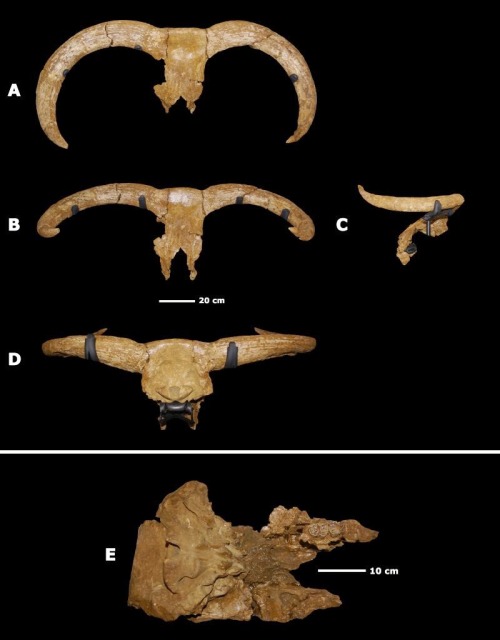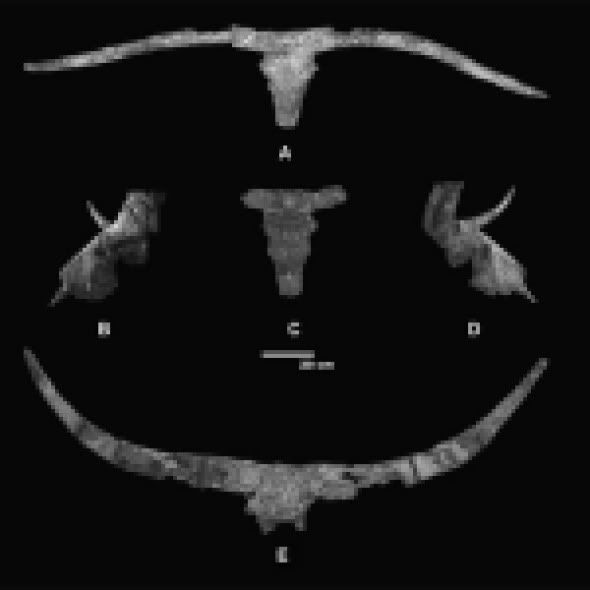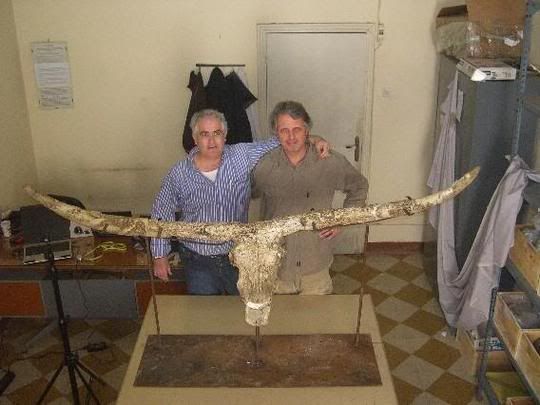Martinez-Navarro
et al. 2014 present a partially preserved cranium with complete horn cores of
the oldest aurochs specimen known hitherto, dated back ~700.000 years and found
in Tunisia. Not only is this a quite large specimen (keep in mind that
geologically young aurochs tended to be larger than most Holocene anyway) but
its horn cores are huge, probably the largest known yet. They measure
112,0-111,5 cm in outer length and lateral span about 150 cm (for comparison,
the horns of the Wörth bull Aretto, which are already large horned cattle, spanned
about 100 cm). Since the keratinous sheath adds 25-10% length to the horn, the
horns of this specimen must have been around 130 cm long, which is very
impressing. Considering its age, I am not sure if it should be classified as B. p. africanus or simply as basal member
of the species before any subspeciation took place.
 |
| The recently discovered oldest aurochs skull known to date |
A common
conception was that the clade Bos is
of (Eur-)Asian origin because a number of extinct possible predecessor genera
are located there (f.e. Leptobos) and
all living members of the clade live there, and further it was suggested that
the Aurochs itself was of Indian origin because the earliest previously known
remains are from India. An alternate hypothesis that is increasingly well
supported is that Bos originated in
Africa since its cranial anatomy is more derived than that of Bison and Leptobos and shares more characteristics with the late
Pliocene-early Pleistocene Pelorovis
(no, not “Pelorovis” antiquus which actually should be classified
as Syncerus antiquus, but P. olduvaiensis and P./Bos turkanensis) [1]. And in fact, the oldest true Bos members, B. turkanensis (which can be interpreted as an intermediate form
between Pelorovis and Bos, and is mutually assigned to both
taxa) and the very long horned B. buiaensis, were inhabitants of
North-eastern Africa.
 |
| Bos buiaensis |
 |
| Pelorovis olduvaiensis |
The fact
that this oldest aurochs specimen known up to date yet is from North Africa
does not necessarily imply the species evolved there. But I do see a certain
continuity between P. olduvaiensis
and this basal aurochs specimen: 1) The angle between the horns and the snout
is much sharper than in many later European aurochs specimen, what is
“suspicious” considering that this specimen is at the root of the species and that
those of Pelorovis are oriented almost
parallel to the snout. 2) The horns of Pleistocene aurochs are more dorsoventrally
compressed than in Holocene aurochs/cattle, and even more so in this specimen (~14
cm vs. ~9,3 cm in diameter). Those of Pelorovis
are very dorsoventrally compressed. 3) The skull of this definitely male specimen
is comparably narrow, and the skull of Pelorovis
is also very narrow.
So the
postulated African origin of Bos and Bos primigenius seems plausible to me as
well. Bos buiaensis has been
suggested as the ancestor of the aurochs, but the fact that its horns are
considerably more outwards-ranging than in both Pelorovis and B. primigenius
makes that unparsimonious. My personal opinion is that it perhaps might be a
sister species and both might have descended from B. turkanensis. Another interesting question is whether the common
ancestor of the Kouprey-Banteng-Gaur clade was either B. turkanensis, another
species or even basal aurochs (although I think the aurochs might be too young
to be a probable ancestor of this clade). So the aurochs must have spread from the
north of Africa to the Near East to all over Eurasia. Interestingly, the Indian
aurochs B. p. namadicus is reported having longer and more wide-ranging horns
than other aurochs populations. Perhaps this indicates hybridization with B. acutifrons, an Asian species that was
similarly long-horned as B. buiaensis,
which died out shortly after the aurochs arrived in that region. Genetics do
indicate that a lot of hybridization within Bos
and also with Bison took place –
Yaks, now recognized to be members of the Bison
clade [2], were introgressed by Bos; Gaurs
and Koupreys introgressed the Banteng [1], and the Wisent probably is a hybrid
of Bos and Bison [2].
The subject
gets even more interesting (and more speculative) when you look at the pinned V-shaped
dorsal edge of the frontal bone between the horns of some Zebus, which pulls
the horns closely together and upwards, giving them an antelope-like
appearance. You will see that P.
olduvaiensis has the same condition. Could that be caused by the same
genetic background inherited by this species that was reactivated by the
altering of the genome through domestication? This is only a wild speculation
of mine.
Combining
all that, I did a little cladogram of my idea on the phylogeny of Bos – without having done a phylogenetic
analysis, but based on the molecular and morphologic data cited and outlined
here and the rough guess that the Kouprey is the sister species of Gaur +
Banteng. Do not take this phylogeny for granted.
P. olduvaiensis à †B. turkanensis + --- + -- †B.
buiaensis
`
`
`
` --- † B. acutifrons
`
`--+ --- B. primigenius
`
`--+ --- † B.
sauveli
`
`--+ --- B.
javanicus
`
` --- B. gaurus
I have to
say I can’t wait to illustrate a life restoration of B. buiaensis, B. p. africanus
and B. p. namadicus and to write a
post on them and their paleoenvironment.
I wondered
why the early members of Bos had
these large horns. Their size is too extreme to serve for defence only, but
could be the result of sexual selection for display like in other bovids like
caprines [3], although the horns of the early aurochs surely were formidable
weapons too. Thermoregulation might be another explanation, since horn cores
are highly vascularized bones and might serve as a tool to get rid of excessive
heat. And no, I do not think that the large horns of early African aurochs and
Watussi cattle are more than a coincident unless there are some conclusive
hints for it. The fact that early Bos
had more forwards-pointing horns than later ones, including North African
Aurochs, might indicate that Iberian
landraces had some africanus
introgression considering that they mostly come from Africa (more on that
later), but I do not think that because taurine cattle probably arrived in NA
after the African aurochs died out.
Literature
[1] Martínez-Navarro, B.,
Karoui-Yaakoub., N., Oms, O. et al., "The early Middle Pleistocene
archeopaleontological site of Wadi Sarrat (Tunisia) and the earliest record of Bos
primigenius", Quaternary Science Reviews (2014).
[2] Maternal and Paternal Lineages
in Cross-Breeding Bovine Species. Has Wisent a Hybrid Origin? Edward L. C. Verkaar,* Isaa ̈c J. Nijman,*
Maurice Beeke,* Eline Hanekamp,* and Johannes A. Lenstra
[3]
Hans-Peter Uerpmann: Der
Rückzucht-Auerochse und sein ausgestorbenes Vorbild.


Fascinating. Your conclusion about hornsize being mostly for display sounds very logical. Especiallly when you consider that fighting cattle, that are only selected on their fighting capabilities, have quite small horns.
ReplyDeleteCould the Nguni cattle of south africa be used for an example an african aurochs project.They are also combination of Zebu (Bos indicus) and Bos taurus
ReplyDelete